山东省沂源县燕崖中学中考语法复习素材:中考复习非谓语动词专题
- 格式:doc
- 大小:109.00 KB
- 文档页数:5

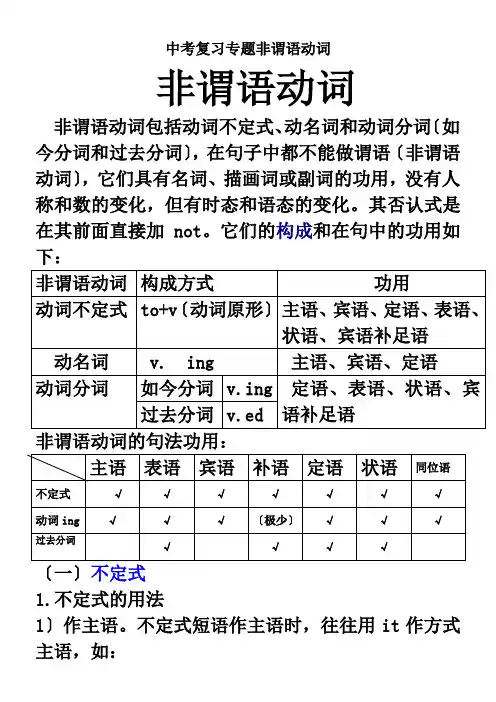
中考复习专题非谓语动词非谓语动词非谓语动词包括动词不定式、动名词和动词分词〔如今分词和过去分词〕,在句子中都不能做谓语〔非谓语动词〕,它们具有名词、描画词或副词的功用,没有人称和数的变化,但有时态和语态的变化。
其否认式是在其前面直接加not。
它们的构成和在句中的功用如下:非谓语动词的句法功用:〔一〕不定式1.不定式的用法1〕作主语。
不定式短语作主语时,往往用it作方式主语,如:To see is to believe. It is right to give up smoking.2〕作宾语。
不定式短语作宾语时,如带有宾语补足语,往往把其放在宾语补足语之后,而用it作方式宾语。
如:He wanted to go. I find it interesting to study with him.3〕作宾语补足语。
如:He asked me to do the work with him.留意:在feel, hear, listen to,look at, notice, observe, see, watch, have, let, make等词后的补足语中,不定式不带to. 但是这些句子假设变成主动结构时,就必需带to,如:He is often heard to sing the song.留意:不定式动词在介词but, except,besides前面时,假设这些介词之前有行为动词do的各种方式,那么,这些介词后的不定式省略to,如:She could do nothing but cry.4〕作定语,通常后置,如:I have some books to read. 留意:作定语的不定式中含有的介词或副词不能省略。
He is looking for a room to live in. There is nothing to worry about.但是,不定式所修饰的名词假设是time, place或way,不定式前面的介词习气上要省去。

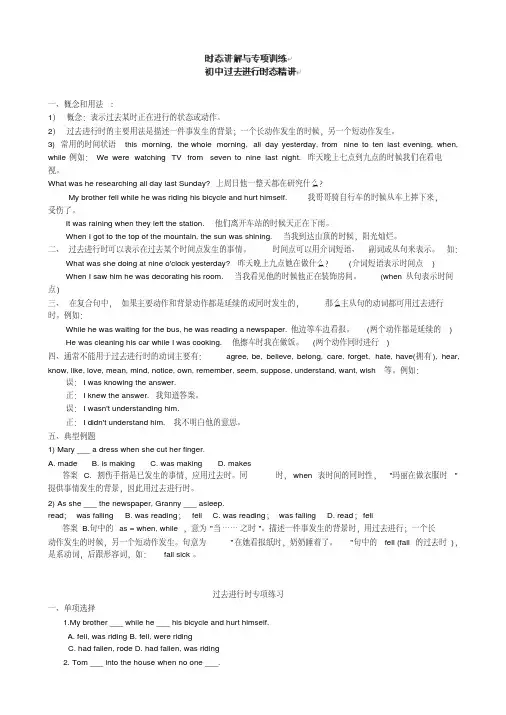
一、概念和用法:1)概念:表示过去某时正在进行的状态或动作。
2)过去进行时的主要用法是描述一件事发生的背景;一个长动作发生的时候,另一个短动作发生。
3) 常用的时间状语this morning, the whole morning, all day yesterday, from nine to ten last evening, when, while例如:We were watching TV from seven to nine last night. 昨天晚上七点到九点的时候我们在看电视。
What was he researching all day last Sunday? 上周日他一整天都在研究什么?My brother fell while he was riding his bicycle and hurt himself. 我哥哥骑自行车的时候从车上摔下来,受伤了。
It was raining when they left the station. 他们离开车站的时候天正在下雨。
When I got to the top of the mountain, the sun was shining. 当我到达山顶的时候,阳光灿烂。
二、过去进行时可以表示在过去某个时间点发生的事情。
时间点可以用介词短语、副词或从句来表示。
如:What was she doing at nine o'clock yesterday? 昨天晚上九点她在做什么?(介词短语表示时间点)When I saw him he was decorating his room. 当我看见他的时候他正在装饰房间。
(when从句表示时间点)三、在复合句中,如果主要动作和背景动作都是延续的或同时发生的,那么主从句的动词都可用过去进行时。
例如:While he was waiting for the bus, he was reading a newspaper.他边等车边看报。

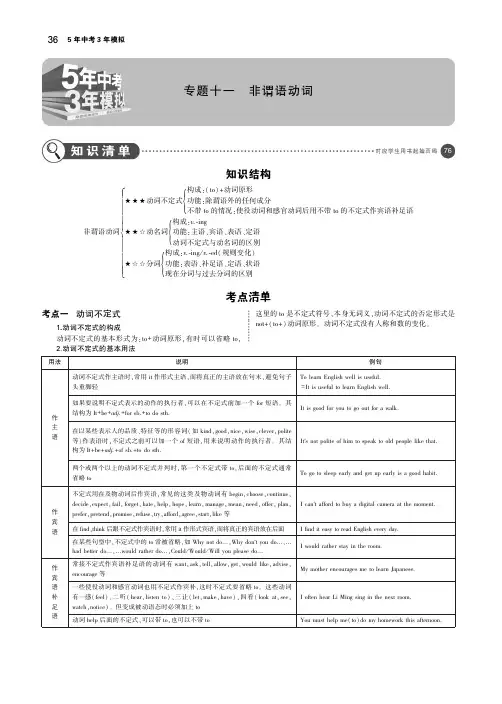
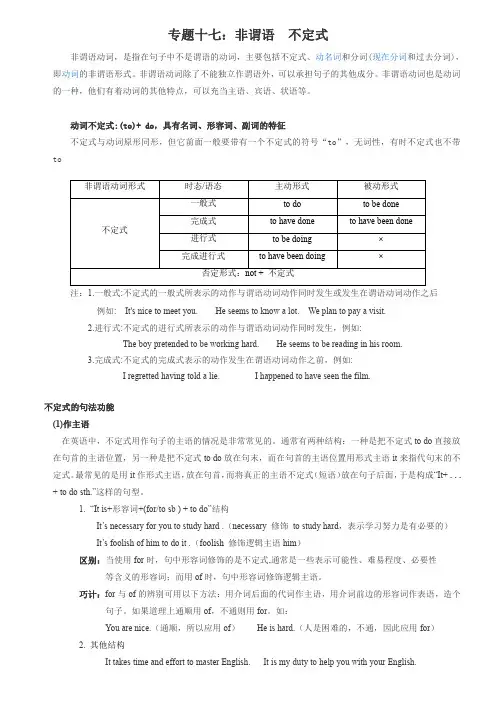
专题十七:非谓语不定式非谓语动词,是指在句子中不是谓语的动词,主要包括不定式、动名词和分词(现在分词和过去分词),即动词的非谓语形式。
非谓语动词除了不能独立作谓语外,可以承担句子的其他成分。
非谓语动词也是动词的一种,他们有着动词的其他特点,可以充当主语、宾语、状语等。
动词不定式:(to)+do,具有名词、形容词、副词的特征不定式与动词原形同形,但它前面一般要带有一个不定式的符号“to”,无词性,有时不定式也不带to注:1.一般式:不定式的一般式所表示的动作与谓语动词动作同时发生或发生在谓语动词动作之后例如:It's nice to meet you.He seems to know a lot.We plan to pay a visit.2.进行式:不定式的进行式所表示的动作与谓语动词动作同时发生,例如:The boy pretended to be working hard.He seems to be reading in his room.3.完成式:不定式的完成式表示的动作发生在谓语动词动作之前,例如:I regretted having told a lie.I happened to have seen the film.不定式的句法功能(1)作主语在英语中,不定式用作句子的主语的情况是非常常见的。
通常有两种结构:一种是把不定式to do 直接放在句首的主语位置,另一种是把不定式to do 放在句末,而在句首的主语位置用形式主语it 来指代句末的不定式。
最常见的是用it 作形式主语,放在句首,而将真正的主语不定式(短语)放在句子后面,于是构成“It+...+to do sth.”这样的句型。
1.“It is+形容词+(for/to sb )+to do”结构It’s necessary for you to study hard .(necessary 修饰to study hard ,表示学习努力是有必要的)It’s foolish of him to do it .(foolish 修饰逻辑主语him )区别:当使用for 时,句中形容词修饰的是不定式,通常是一些表示可能性、难易程度、必要性等含义的形容词;而用of 时,句中形容词修饰逻辑主语。
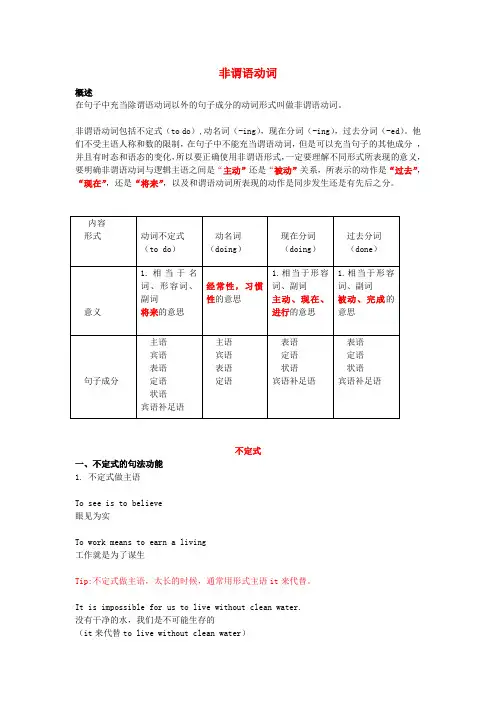
非谓语动词概述在句子中充当除谓语动词以外的句子成分的动词形式叫做非谓语动词。
非谓语动词包括不定式(to do),动名词(-ing),现在分词(-ing),过去分词(-ed)。
他们不受主语人称和数的限制,在句子中不能充当谓语动词,但是可以充当句子的其他成分,并且有时态和语态的变化,所以要正确使用非谓语形式,一定要理解不同形式所表现的意义,要明确非谓语动词与逻辑主语之间是“主动”还是“被动”关系,所表示的动作是“过去”,“现在”,还是“将来”,以及和谓语动词所表现的动作是同步发生还是有先后之分。
不定式一、不定式的句法功能1.不定式做主语To see is to believe眼见为实To work means to earn a living工作就是为了谋生Tip:不定式做主语,太长的时候,通常用形式主语it来代替。
It is impossible for us to live without clean water.没有干净的水,我们是不可能生存的(it来代替to live without clean water)2.不定式做宾语We need to take measures to prevent people from damaging environment.我们应该采取措施阻止人们破坏环境I want to watch TV.我想看电视3.不定式做表语(说明主语的内容、性质、特征)主语通常是表意向、打算、计划的词,如:wish,idea,task,purpose,duty,dream,aim 等,常用to do 不定式做表语My dream is to be a teacher.我的梦想是成为一名老师My duty is to take good care of my little sister.我的责任就是照顾我的妹妹4.不定式做定语(后置定语,来修饰名词)常见不定式做后置定语的词:way,ability,chance,time,place,the first,the second,the only,the last 等I have a lot of homework to do .我有许多作业要做He is the first to come and the last to leave.他是第一个来的,最后一个走的She has enough money to buy a computer.她有足够的钱买一台电脑5.不定式做宾补(V+sb to do sth)My mother tells me to do my homework first.我的妈妈告诉我要先做作业He invited us to go for a picnic last weekend.上周末他邀请我们去野餐6.不定式做状语(状语是用来修饰动词的)(1)做目的状语I come here to tell you that I have finished doing my homework.我来是为了告诉你我的作业已经写完了(to tell you...做目的状语)He bought a bag of food to eat他买了一包食物吃(to eat 做目的状语)(2)做结果状语He got to the station,only to find the train has already left .他到达车站,发现火车已经离开了(火车离开是结果状语)He is too young to go to school.他太小了而不能上学(不能去上学是结果)(3)原因状语I am sorry to hear that you lost your wallet.听说你的钱包丢了我很难过(难过的原因是钱包丢了)They were excited to hear the news.他们听到这个消息很激动(激动的原因是听到了消息)二、接不定式作宾语的动词(V+to do sth)afford(支付得起),agree(同意),aks(要求)choose(选择),continue(继续),decide(决定)dare(敢于),expect(期望),fail(失败)help(帮助),hope(希望),learn(学),like(喜欢)manage(成功),offer(提供)plan(计划)prepare(准备),promise(承诺),prefer(更喜欢)refuse(拒绝),want(想要),wish(希望)三、接不定式作宾补的动词(V+sb to do sth)tell,ask,want,wish,warn,teach,expect,encourage,allow,advise,remind,require,requ est,permit,persuade,order,need,leave,invite,hate,force,command,beg等四、不带to的动词不定式(1)感官动词hear,see,watch,notice,feel等后跟不带to的不定式感官动词+sb+do sth表示:动作的全过程感官动词+sb+doing sth表示:动作正在进行(2)使役动词make,let,have(使,让)+ sb do sth 让某人做某事。
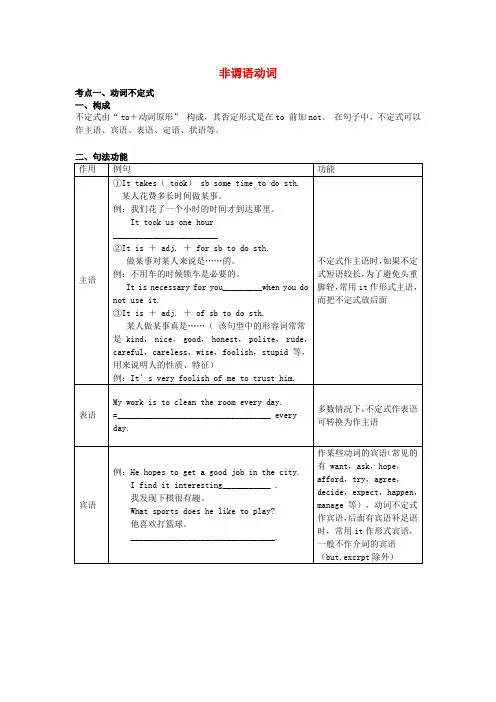
非谓语动词考点一、动词不定式一、构成不定式由“ to+动词原形” 构成,其否定形式是在to 前加not。
在句子中,不定式可以作主语、宾语、表语、定语、状语等。
注意:1、 在kind,good,nice,clever,等表示人的品质、特征的形容词后,不用for 而用of例:你那样做真是太聪明了。
________________________________________________2、 一些使役动词和感官动词也用不定式作宾补,这时要省略to.这些动词有:一感(feel ),二听(hear, listen to )、三让(let,make,have )、四看(look at,see,watch,notice ),但这些动词变成被动语态时,必须还原to 例:The boss made them work the whole night 。
____________________________________________________3、 不定式作定语:如果是不及物动词,且与所修饰的词之间有被动关系,要在不定式后面加上介词。
例:没什么可担心的。
______________________________________________________4、常和疑问词 what , which , who , whom , how , when , where , whether 等连用,相当于宾语从句。
它们常用在 know ,wonder ,ask ,tell ,decide 等动词的后面,该结构也可在句中作主语或表语。
例:The problem is how to get to the hotel.老师正告诉学生们要做什么。
_____________________________________________________________考点二、分词一、构成分为现在分词和过去分词两种。
你须理解的要点:1、什么是非谓语动词;2、非谓语动词在句子中的用法,即非谓语动词可以当哪种成份(什么语);3、常用非谓语动词的形式;4、考试经常考到的某些谓语动词后面把非谓语动词充当宾语、补语的各种习惯用法:到底是to do或do还是doing、done。
前言:动词除了主要在句子中当谓语之外,还可以当主语、宾语、表语、定语、状语、补语(用于补充说明宾语的,全称宾语补足语),此时的动词统统称为非谓语形式。
动词在句子中当谓语时,须详细考虑时态上的问题(过去、现在、将来)、状态问题(一般、进行、完成)、语态问题(主动、被动)等。
动词在句子中当主语、宾语、表语、定语、状语、补语时,——虽然有时候也得考虑上述项目,但那是高中一级的知识,目前初中阶段只涉及——考虑三种形式:to do (或do,即省略to了的不定式)、doing、done,即不定式、动名词、过去分词。
一、下面只举例常见用法。
当主语:e.g.1、To buy this book took me 100 yuan.2、Running is good for your health.★注:不定式当主语时常放到句子后面去,而在原来的位置以形式主语it 来代替。
e.g.To buy this bike took me 100 yuan.——→It took me 100 yuan to buy this book .当宾语(常考):e.g.3、They decided to buy a new TV. 4、We enjoy talking in English. 当表语:e.g.5、My work is to feed the animals .当定语:e.g.6、Have you got something to eat ?Do you know the crying boy ?( 动名词当定语)当状语:e.g.7、I must go home to get some more money . (目的状语)8、The man's cutting the big tree (by) using a long knife(方式状语)(by常省略)当补语(常考):e.g. 9、Mr Wei asked me to go with him .10、Did you make the boy laugh ?11、We saw a woman running along the road . 12、We had our pictures taken .二、常考知识点有1、不定式、动名词作宾语,2、不定式、动名词或过去分词作补语。
其它用法,即作主、表、状、则少见。
因此须掌握有哪些动词作谓语时,它们的后面常跟何种非谓语动词形式作宾语或补语。
例如:enjoy 后只跟doing作宾语;want 后只跟to do 作宾语;start 后既可跟to do 又可跟doing作宾语,而意思一样;forget 后既可跟to do 又可跟doing作宾语但意思不一样……三、下列动词作谓语时,其后面只跟不定式作宾语或补语。
1>want、need、wish、hope、agree、decide、plan、afford、pretend、mean、manage、choose、refuse等后有第二动词作宾语时,须采用不定式形式。
e.g. I want to take some books to the classroom.The schoolgirls hope to be policewomen in the future.Do you think he can afford to buy the digital camara ?We need to buy some more food for our supper.2>ask、tell、teach、allow后面跟有第二动词作补语时,须采用不定式形式。
e.g.Mr Green asked Xiao Ming to go with him.Could you teach me how to play computer games ?We don't allow them to do like this!★注1:help 这个动词比较特殊,其后面不定式作宾语或补语既可带to也可以不带to.e.g. The boy helped her mother (to) feed the animals. (当宾补)We must help (to) put away the clothes. (当宾语)(具体地说有to时表示主语不直接参与动作,只是提供条件予以帮助;无to时表示主语直接参与动作。
如下:)e.g. Computers can help us to solve many problems.电脑帮我们解决很多问题。
(电脑只是提供了计算上的便利条件,而解决问题最主要的还是我们自己。
)We help decorade the Chrismas tree. 我们帮忙装饰圣诞树。
(我们直接参与一起做) ★注2:但当今英语中help后的不定式当宾/补语时带to或不带to都已经不分得很明显了。
★注3:want、need两词后若跟动名词则可表达被动之意:e.g. The trees want watering in time. 这些树得按时浇水(被浇水)。
The house needs repairing .这房子得修补了(被修补了)。
(可用to be repaired代替)★注4:need 在肯定句中当作实义动词,后跟带to的动词不定式作宾语:I need to go by myself. need 在疑问句、否定句中当作情态动词,后跟无to的动词作谓语:I needn' t go any more.四、下列动词(或动词词组)作谓语时,其后面只跟动名词作宾语,(作补语的比较少见)。
enjoy、finish、practise、keep、mind、miss(错过)、give up、put off、keep on、take part in 、make a contribution to 等。
e.g. I enjoy swimming so much.Have you finished reading the book yet ?The little boy keeps playing all day.My father has given up smoking .五、有些动词的后面既可跟不定式又能跟动名词作宾语,(作补语的比较少见)。
1)后面既能跟不定式又能跟动名词作宾语,且意思基本上一样的,有下列动词:begin、start、prefer、continue、 e.g. Let's begin to run/ running ,OK?When shall we continue to go /going on a field trip ?2)后面既能跟不定式又能跟动名词作宾语,但意思分别不同的,有下列动词:stop 、go on 、try 、remember、forget 、learn 、regret、find、hate、like等。
e.g.1、Stop writing and listen to me. 不写了,听我说。
(停下正在做的事<写>)We've walked so far, why not stop to have a rest ?我们都走得这么远了,为何不停下休息一阵子?(停下正在做的<走>,去做另一件事<休息>) 2、Don't stop, we should go on working !我们继续工作。
(继续原来做的事)If you have finished your homework, you can go on to check it out .如果你们已经做完作业,接下来可以检查作业了。
(接着做另外一件事)3、Since we have been here, we must try to finish our work in time.我们既然已经来了,就得努力/设法及时完成这项工作。
(已着手做事,关键在于想办法做好) Hewant to try finishing the work within a week..他想试看能否在一周内完成这项工作。
(只想尝试一下,成功与否无关紧要)4、Remenber to turn off the light before you leave.走前记得关灯。
(要记住尚没发生的事)I remember seeing him.我记得见过他。
(做过的事记忆犹存)5、Don't forget to bring your English book to school tomorrow.别忘了明天带你的英语书来学校。
(忘记要去做某事,这个某事的动作尚未发生)Sorry, I forget (about) saying something to you.★注:常有about在forget的后面对不起,我忘了跟你说些什么来着。
(忘记了做过的某事,某事的动作已经发生)6、I regret to tell you that I don't agree with you.我遗憾地告诉你,我不同意你。
(对要做的事<当前动作>表示遗憾)How I regret helping such a person!我多么后悔帮了这种人!(对已发生的动作表示后悔)7、Edison's mother found him to be a good pupil.爱迪生的妈妈发现他是个好学生。
(当补语)We found the man cutting a big tree .我们发现那个人正在砍一棵大树。
(当补语)8、I like swimming a lot.我非常喜欢游泳。
(一向以来的爱好或习惯)I like to swim with you this afternoon.我愿意与你今下午去游泳。
(表示当时某一次的选择)9、My uncle hates smoking .我叔叔厌恶抽烟。
(一向厌恶抽烟这件事,不论是谁抽)My uncle hates to smoke 我叔叔讨厌(不想)抽烟。
(讨厌这次自身去<实施这动作>抽烟)我妹讨厌在别人面前喝可乐。
(表示某次的当时有人在,小妹讨厌而不喝,无人时还是想喝的) 六、有些动词作谓语,其后面采用不定式作补语时,常把不定式中的to 省略去。